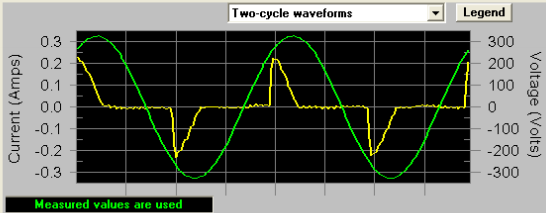While switch-mode power supplies have many advantages, one of their disadvantages is that they are a non-linear load, and because of that can inject harmonic currents into the electrical distribution system. Devices with switching supplies include domestic appliances (TVs, microwave ovens, lighting equipment and dimmers), and office equipment (PCs, printers). Motor-driven equipment can also cause harmonic distortion.
 Non-linear loads, like the one shown above, can inject harmonic currents into the electrical distribution system
Non-linear loads, like the one shown above, can inject harmonic currents into the electrical distribution system
There are numerous case histories of serious problems caused by excessive current harmonics. Transformer overheating is probably one of the more common events. Transformer failure in turn leads to power outages for whole neighborhoods and/or factories and businesses.
Some events can even upset the control system of the high voltage grid, leading to widespread power failures. Overheated neutral lines have caused fires in office buildings, and sensitive electronic equipment has failed because of short voltage dips caused by “misbehaving” electrical equipment. Clearly, power quality standards have become just as necessary as safety standards.
Efforts to limit harmonics date back to the 1930s. More recently, the International Electrical Committee (IEC) Technical Committee 77 (TC77) began work on a standard to limit current harmonics at meetings held in Moscow (1977) and The Hague (1979). This work culminated in IEC 555.2, first published in 1982, and revised in 1984, 1986, and 1991. In the process, a Euro Norm called EN 60555.2, based on one of the intermediate revisions, was released. In December 1993, TC77A submitted a further revision document, known as Central Office no. 41 (CO-41), for approval. This document was approved by a majority of IEC member countries, and thus became EN 61000-3-2. The standard is also referred to as IEC 61000-3-2 and is identical to CO-41.
As of January 1, 2001, all electrical and electronic equipment that is connected to the public mains, up to and including 16A max. rated input current, must comply with EN 61000-3-2 to obtain the CE mark. The CE mark allows a product to be sold throughout the European Union without having to pass tests in each individual country.
The intent of the EN 61000-3-2 standard (and other EC EMC standards, such as EN 61000-3-3) is to force manufacturers to produce products that “behave well” when connected to the supply system. Electrical and electronic products that pass EN61000-3-2 tests are guaranteed not to deteriorate AC power quality beyond specified limits.
The California Instruments CTS Series is a complete, turn-key system for performing EN/IEC 61000-3-2 and other IEC EMC tests. It consists of an AC power source, a power analysis conditioning system (PACS) and a PC based data acquisition system. The Windows™ based CTS software performs full compliance testing for current harmonics emissions of class A, B, C and D products, and supports both the 1998 and 2001 (Amendment 14) versions of the standard. After running a test, the system stores the test data to disk for post-test analysis, and generates detailed test reports.
For more information on EN61000-3-2 and other EC EMC standards, see AMETEK Programmable Power Application Note 119B, “California Instruments CTS Series Compliance Verification Tutorial.”
